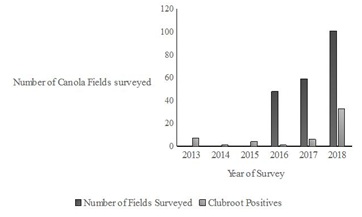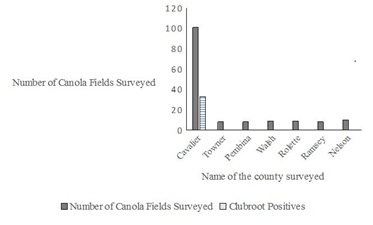ABSTRACT
Clubroot on canola was regular and more prevalent than expected in Cavalier County in the current survey. Prevalence of clubroot on canola has been increasing at rapid pace in North Dakota and has been confirmed in 33 fields in Cavalier County in 2018, which is five times more than it was in 2017. Contrastingly, no clubroot positives were found in any other canola growing counties of North Dakota that were surveyed. Continuous survey in coming years is needed to prevent the spread and to design management plan of clubroot along with extensive outreach activities throughout North Dakota to educate growers in identifying clubroot disease, the biology of the pathogen, its spread and prevention.
Keywords
Canola; Clubroot; Plasmodiophora brassicae
Clubroot of canola caused by Plasmodiophora brassicae (Woronin) is the new emerging disease in North Dakota since its identification on canola in 2013 (Chittem et al. 2014). Clubroot is a soil borne disease that causes swellings, or galls on the plant roots of Brassicaceae family (Dixon 2009). These galls cause on farm premature ripening of canola plants and yield loss in the canola (Strelkov et al. 2005). Examination of roots for galls by digging up from the affected areas is the quick identification of clubroot incidence (Khangura and Wright 2012). Clubroot disease incidence and development is favored by acidic soils (Tewari et al. 2005). However, later research proved that clubroot on canola is not only limited to acidic soils but can also occur in alkaline soils (Strelkov et al. 2007). The highest degree of clubroot disease infestation was observed at pH 6.6 (Palm 1963). P. brassicae is soil-borne obligate parasite thrives in the soil as resting spores that can remain viable in the soil up to 17.3 years indicating crop rotation of 3-4 years may not be a viable option and can spread from field to field on both agricultural and non-agricultural equipment (Wallenhammar 1996). Three-year survey was conducted by a survey group consisting one plant pathologist, two extension specialists of Langdon Research Experiment Station, Langdon, North Dakota and one agricultural agent of Cavalier County, North Dakota. Current objective of determination of clubroot spread and prevalence was done by visual inspection of canola plant roots for galls at two phases in the growing season; once at flowering (10 -100%) stage and at swathing of canola in seven northeastern counties (Pembina, Walsh, Nelson, Ramsey, Towner, Rolette and Cavalier) of North Dakota. The survey was done from the main entrance of the field, where the survey group walked along in a “W” pattern by stopping at 10 spots and uprooting 10 consecutive stems from the ground at each spot. Excess soil was shacked off. Roots then were visually examined for presence of galls. The three-year data prior to 2016 was obtained from North Dakota State University, industry and commodity group surveys done in Cavalier County North Dakota (Figure 2). Selection of counties to survey was done based on canola acreage planted in that particular year and on assumptions of P. brassicae resting spore disseminated in all directions through equipment, soil, and water to neighboring counties of Cavalier. In each county, one field in every 5,000 acres was scouted. Soil samples were collected from the clubroot positive and likely positive fields with an intent to know the pH of the infected soil at which clubroot infections were found. In all, a minimum of 5-10 fields per county were targeted for scouting. The survey results indicated that clubroot on canola was more prevalent in Cavalier County than expected in low pH soils that ranged from 4.5 to 6.4. Likewise, the survey results indicated that the prevalence of clubroot on canola has been increasing at rapid pace in North Dakota and has been confirmed in 33 fields in 2018, which is five times more than it was in 2017 (Figure 1), apart from Cavalier County there were no clubroot findings in any other counties surveyed (Figure 2). Disease surveys have been very crucial worldwide in managing a newly emerging disease like clubroot. Research reports of canola survey in central Sweden indicated that 78% of 190 fields surveyed were infested with clubroot (Wallenhammar 1996).
Survey reports of clubroot in Alberta and Manitoba provinces of Canada confirmed over 3000 and 600 canola fields respectively were clubroot positives (Strelkov, 2018. Personnel communication at Clubroot International workshop). Spread of clubroot can be reduced by thorough sanitation and through adopting integrated disease management consisting disease resistant cultivars, longer crop rotations, and soil reclamation (Donald and Porter 2009). Extensive crop survey, determination of soil pH of canola fields with clubroot was found to be an important arsenal in educating growers about the prevalence of clubroot in North Dakota on Canola. The prevalence data will be more fruitful when integrated with other available clubroot management practices. Survey and prevalence data can be used in outreach activities to educate producers in identifying the disease, inform of potential risks and to encourage clubroot monitoring and adoption of sanitation practices. Removal of potentially contaminated soil from field equipment is an ideal one if practiced (Strelkov et al. 2011). Likewise, length of crop rotation with canola can be determined with the knowledge of detection of clubroot in a field. Finally, clubroot on canola may be more prevalent than expected in North Dakota. Catching it early and being proactive is crucial to manage such a yield robbing and difficult to control disease. Likewise, extensive research needed to develop a better understanding of clubroot risk and its management in canola in North Dakota conditions.
Acknowledgement
The authors acknowledge funding support from North Central Canola Research Program USDA/NIFA, North Dakota Crop Protection Product Harmonization Board and Northern Canola Growers Association. Special thanks to Ron Benada, Drs. Chittem and Del Rio for their help in survey and Randy Mehlhoff for reviewing this article, all the growers with phone call requests to visit their fields for clubroot diagnosis and to the agriculture extension agents, commodity groups and industry personnel that helped in the survey and in conducting clubroot awareness meetings in respective counties.
Figures
Figure 1: Spread of clubroot of canola in Cavalier County of North Dakota since its first report in 2013 to 2018.
Figure 2: Canola fields surveyed in 2018 for the prevalence of clubroot in various northeastern counties of North Dakota.



